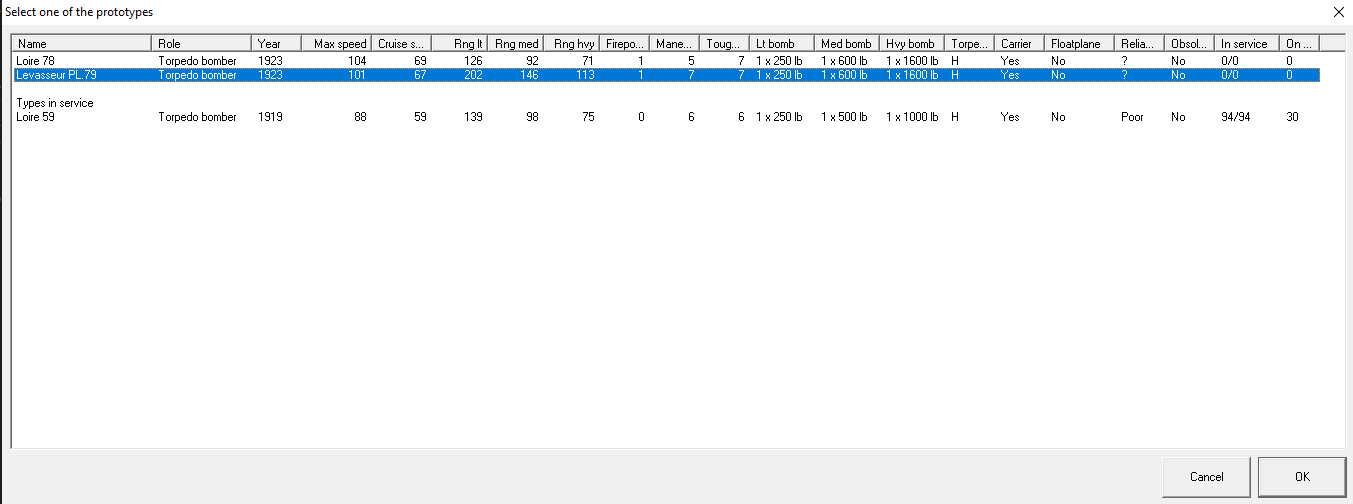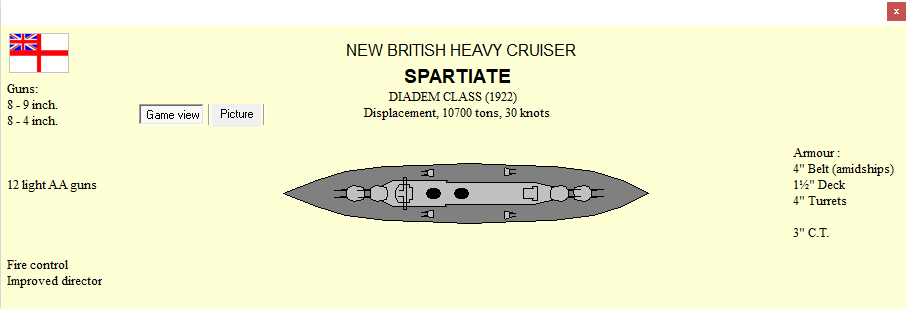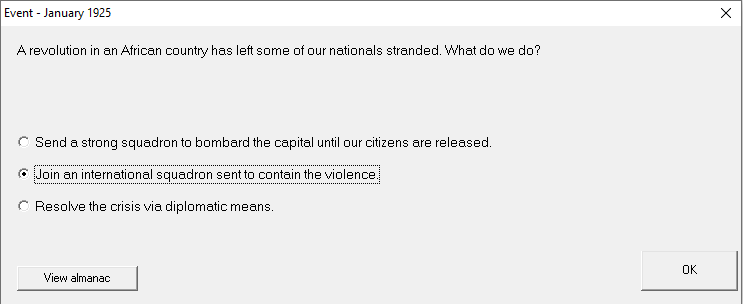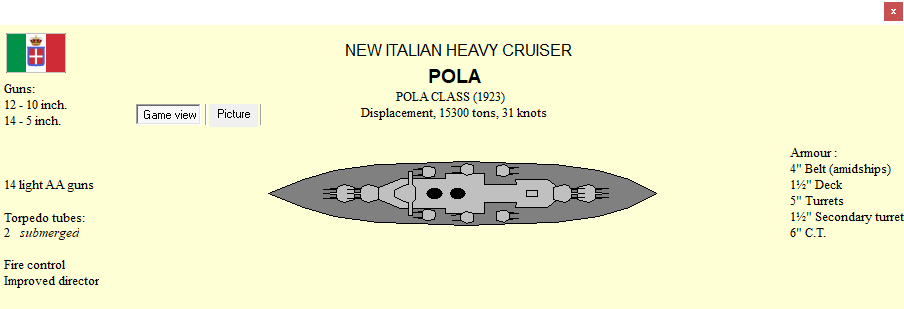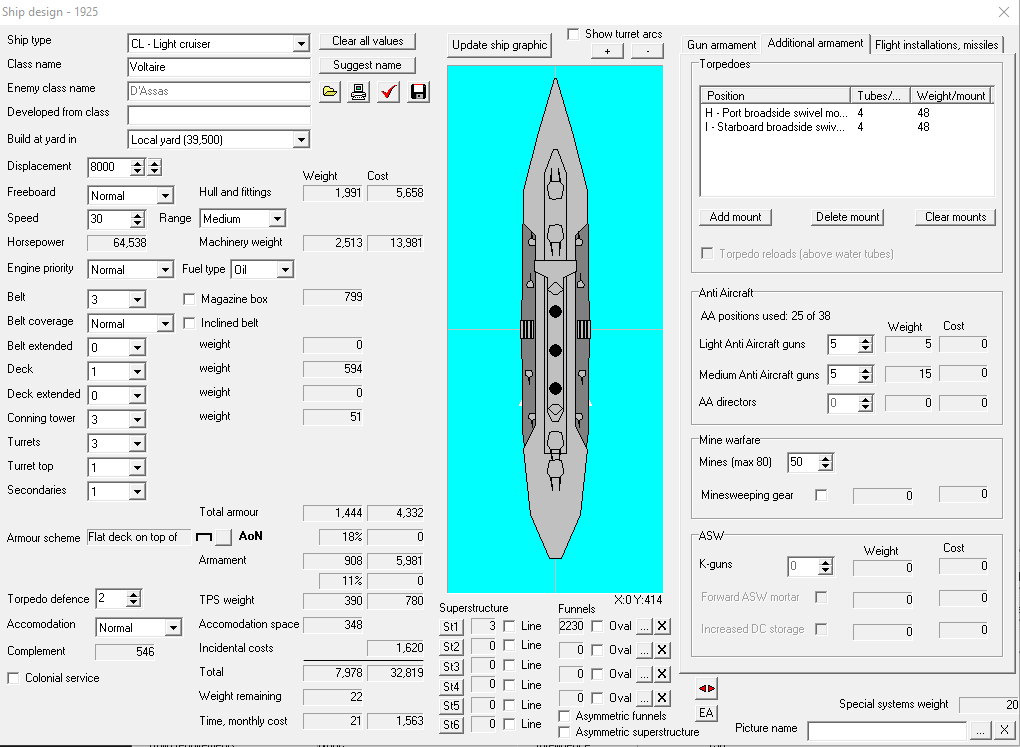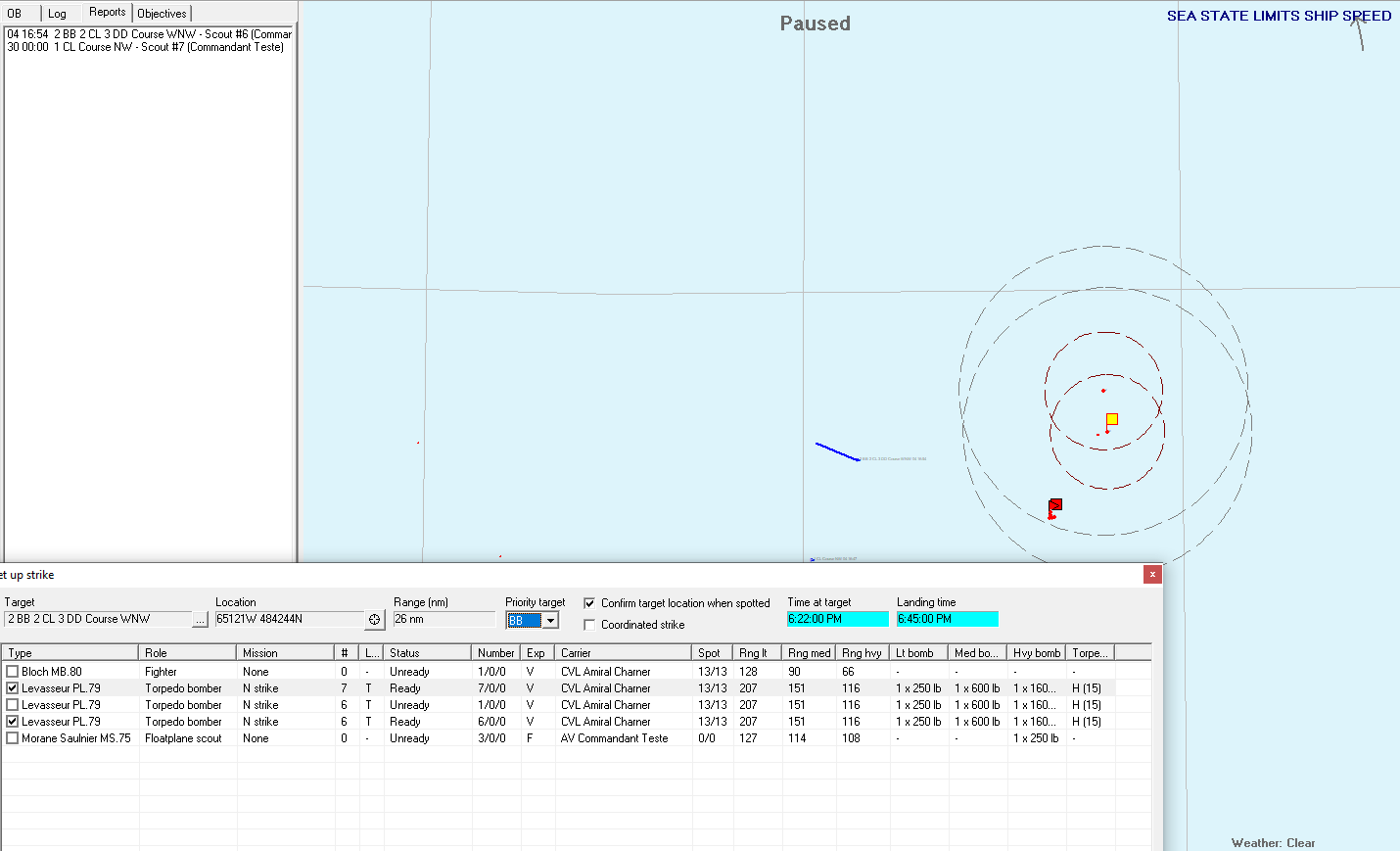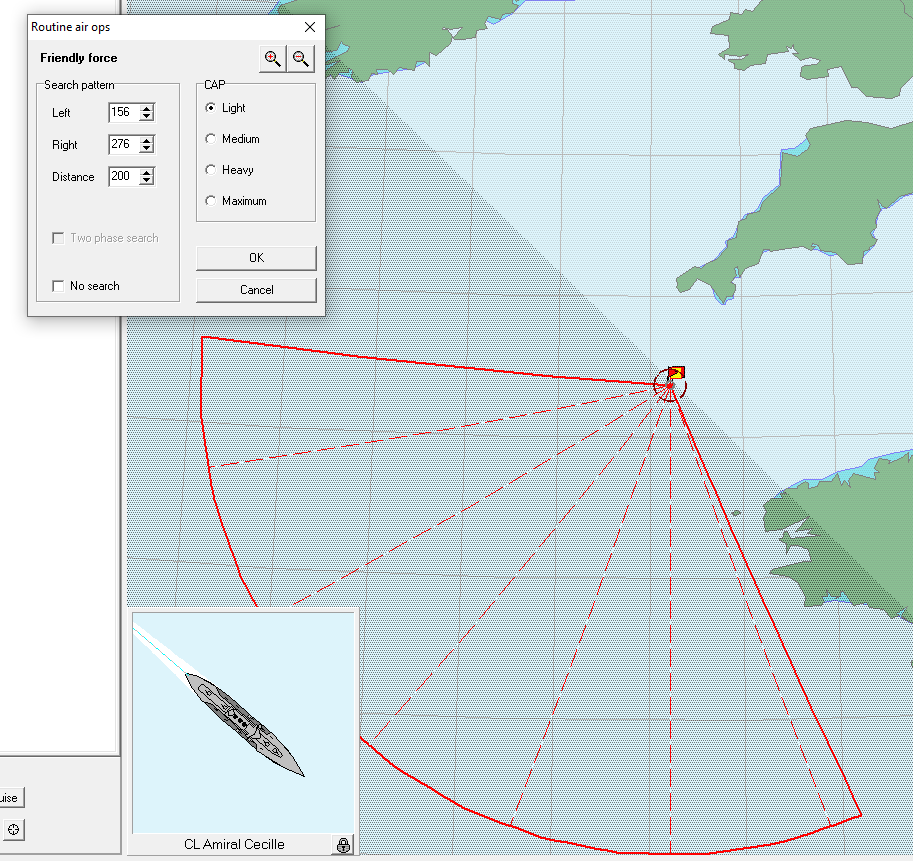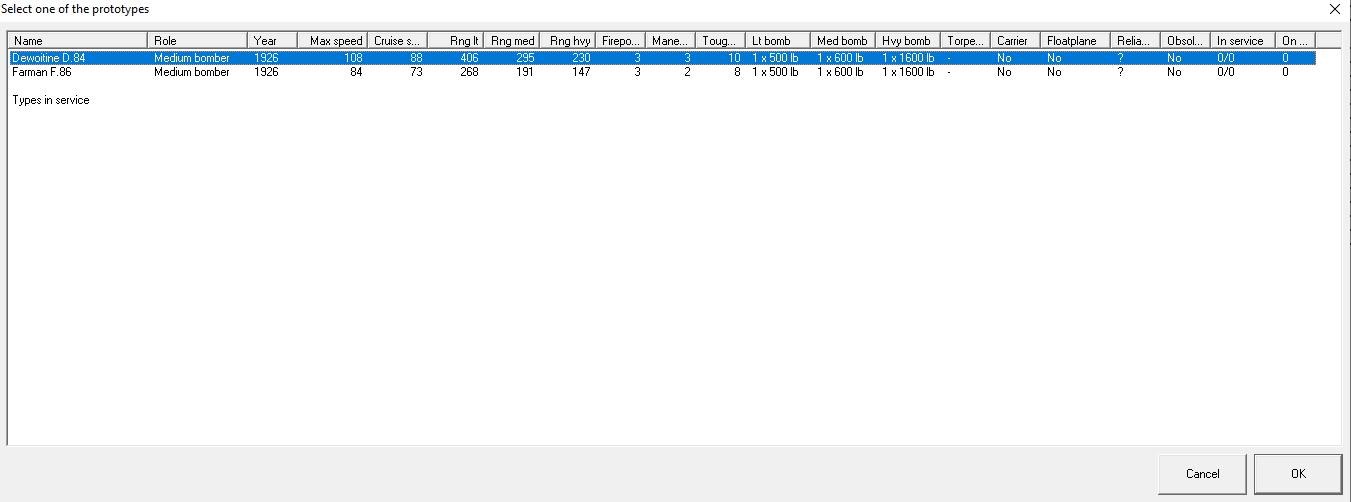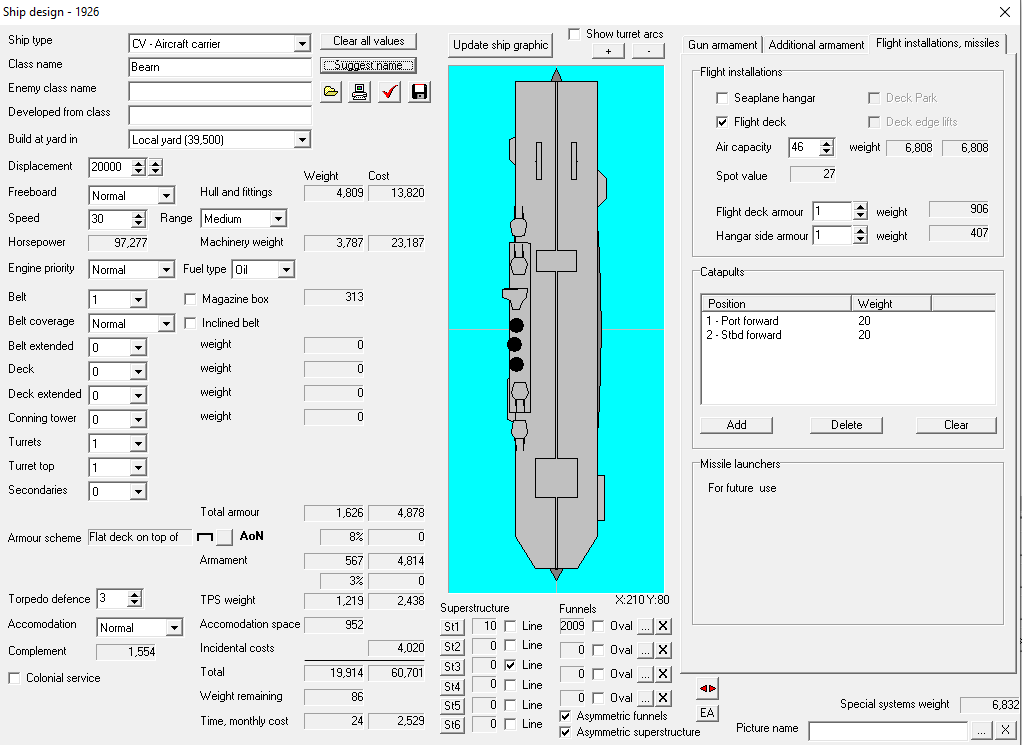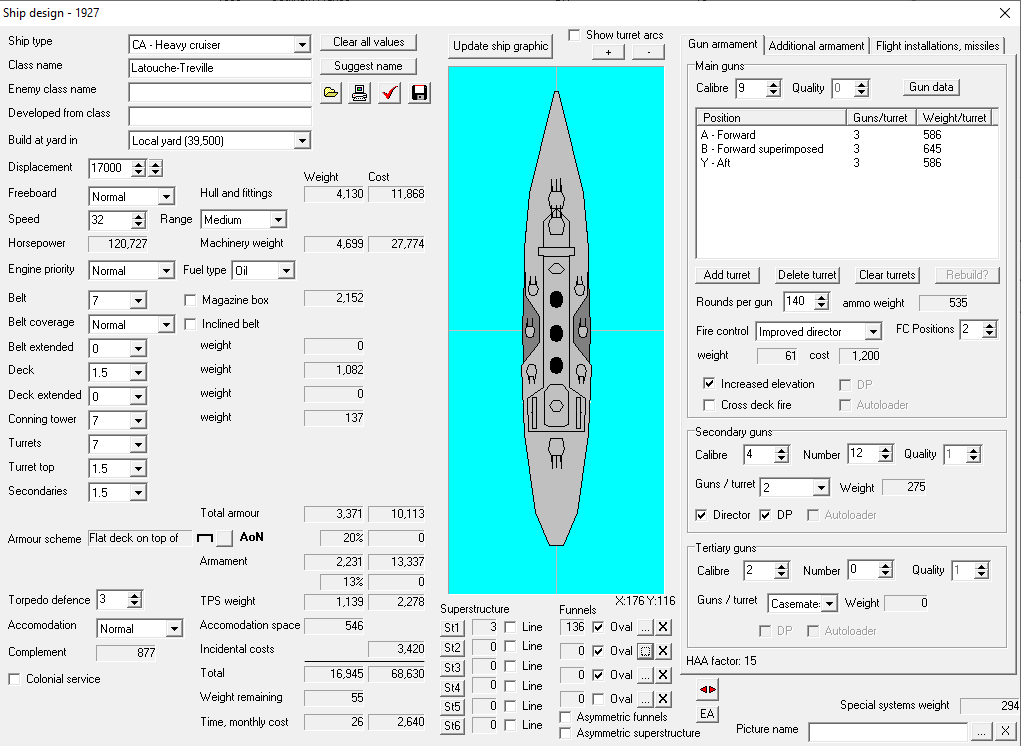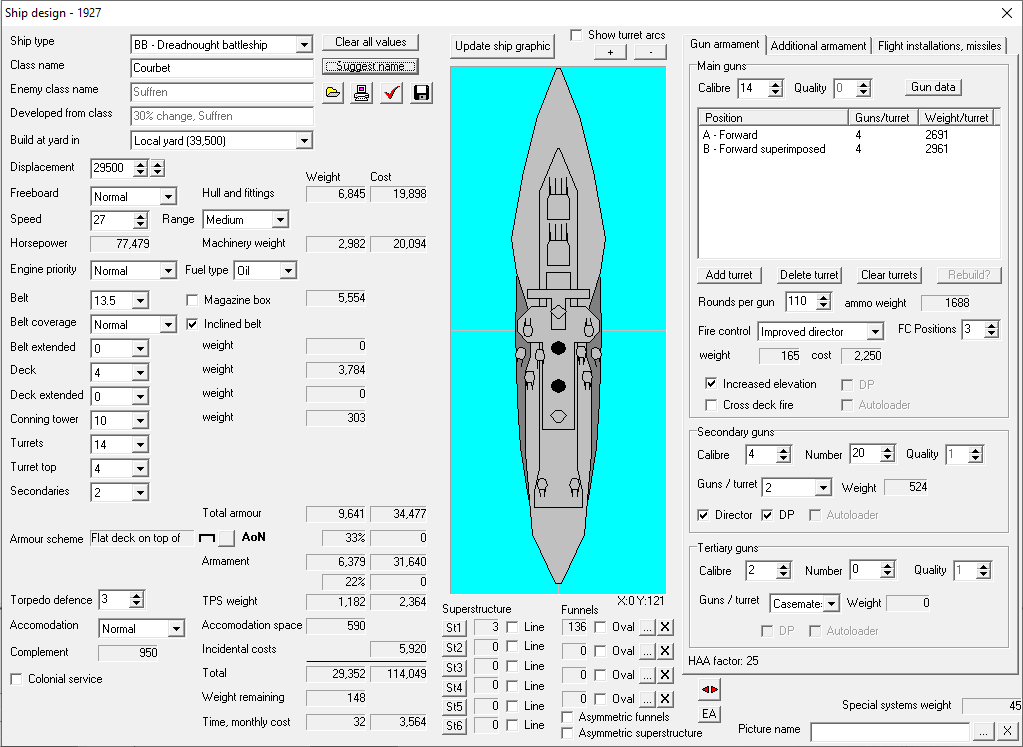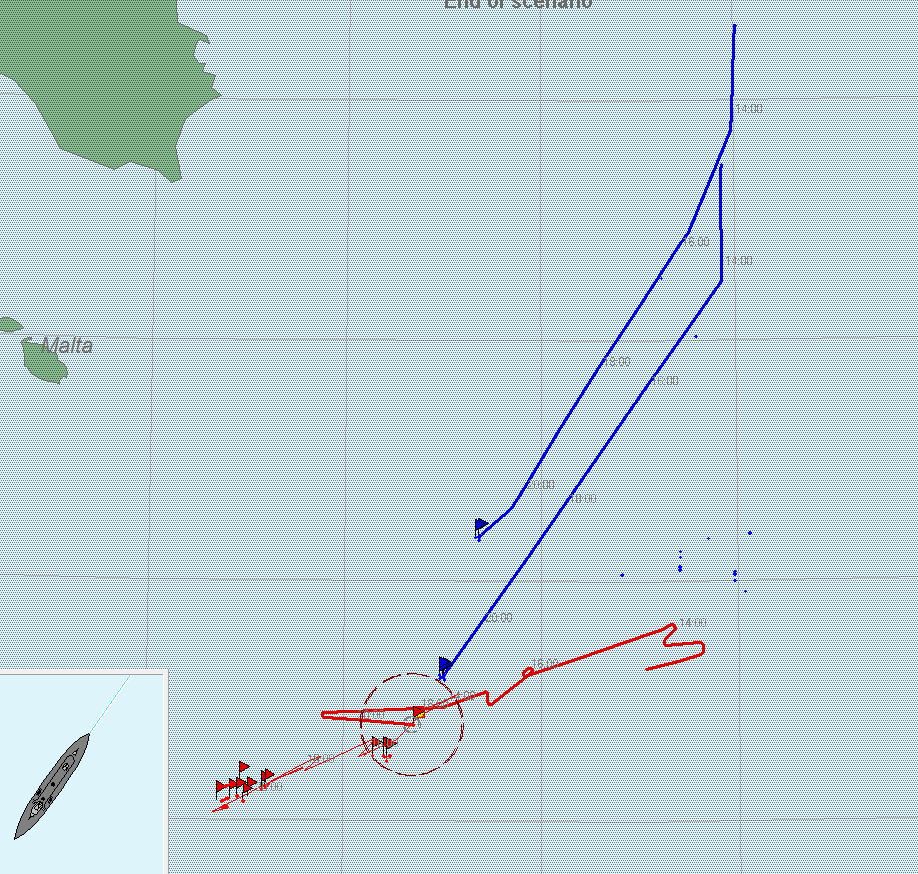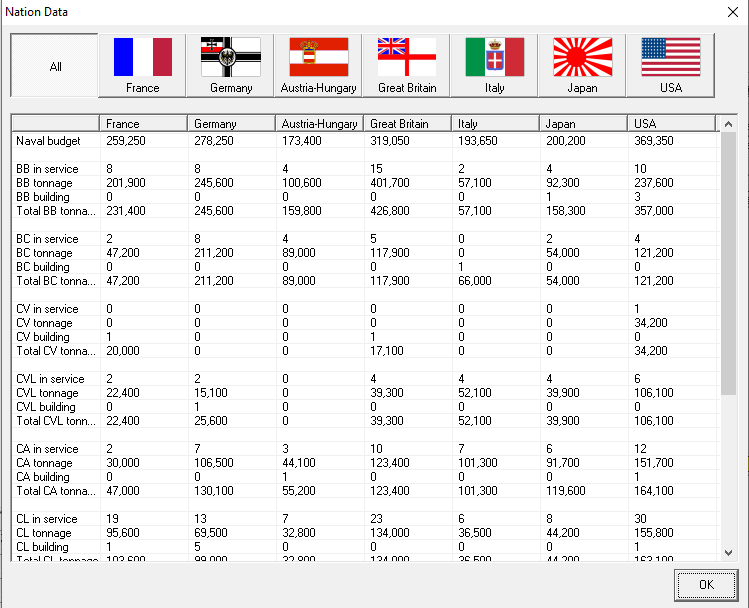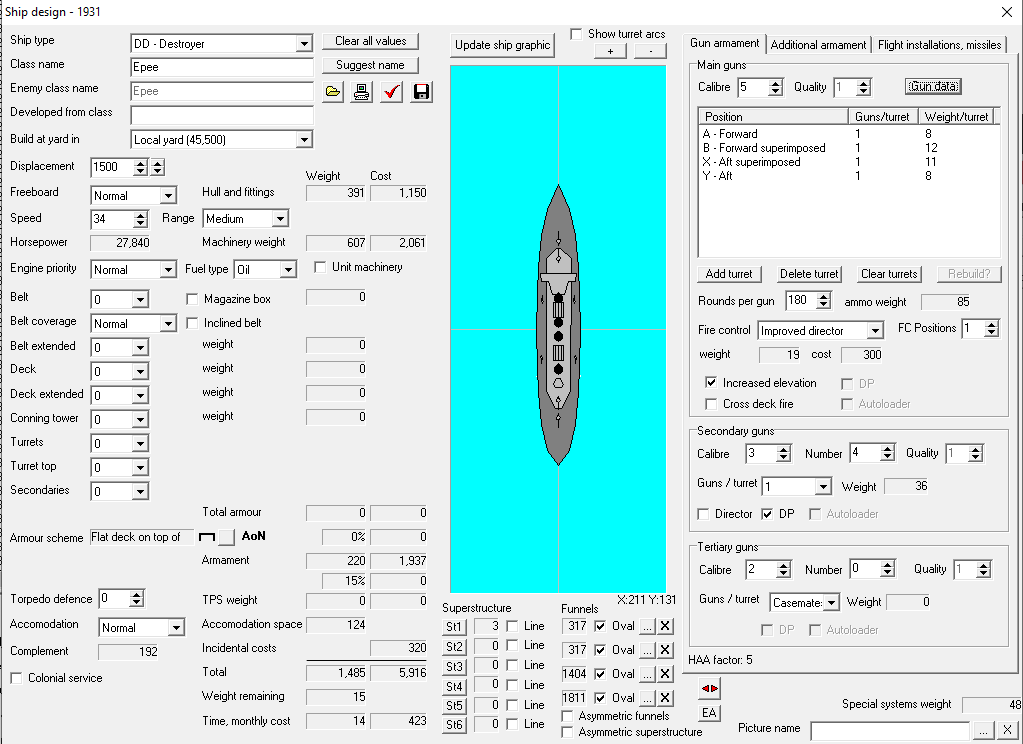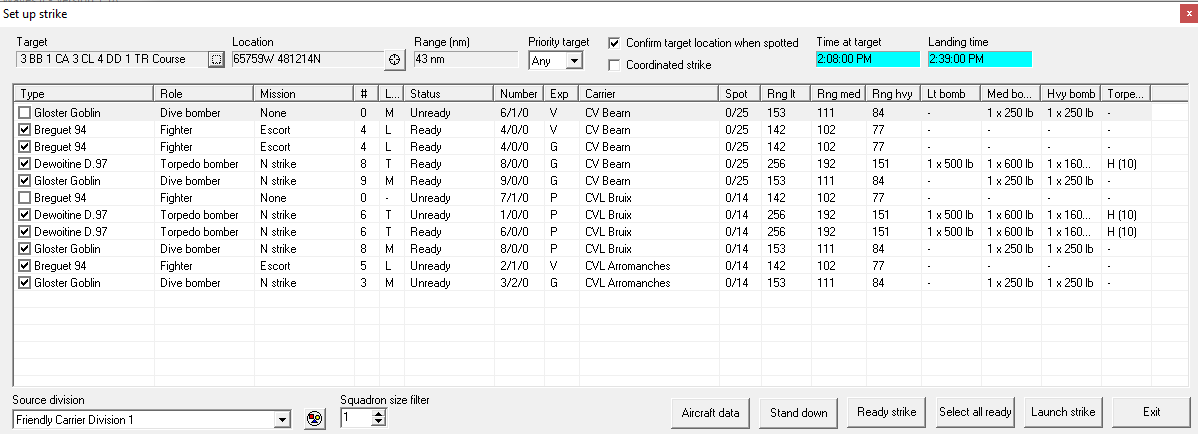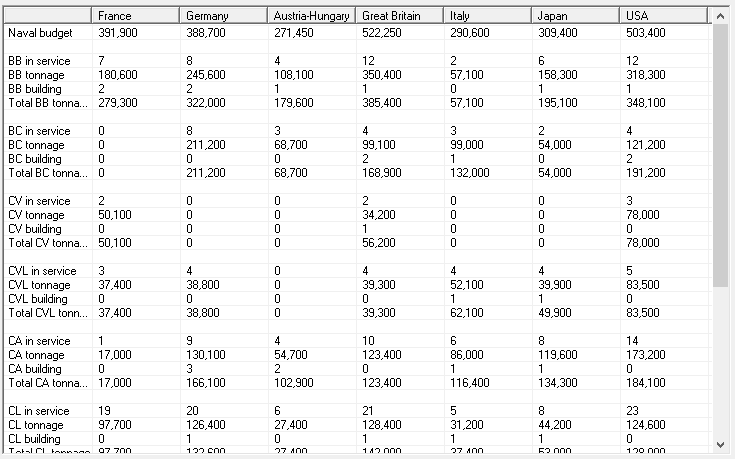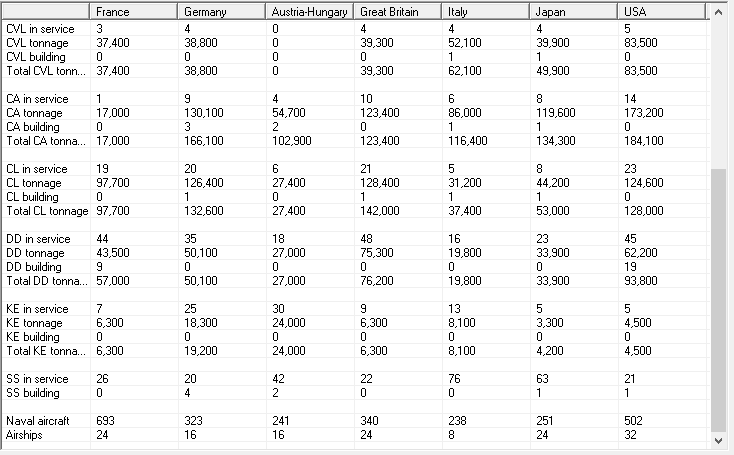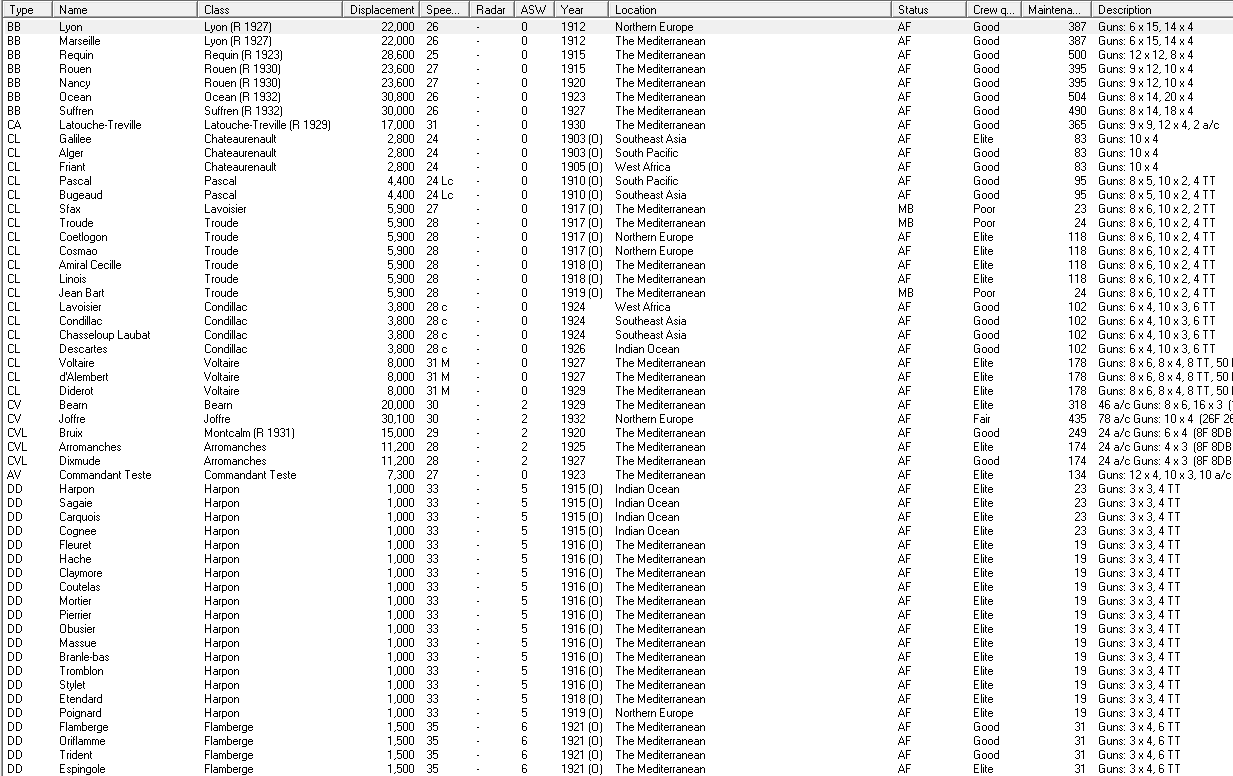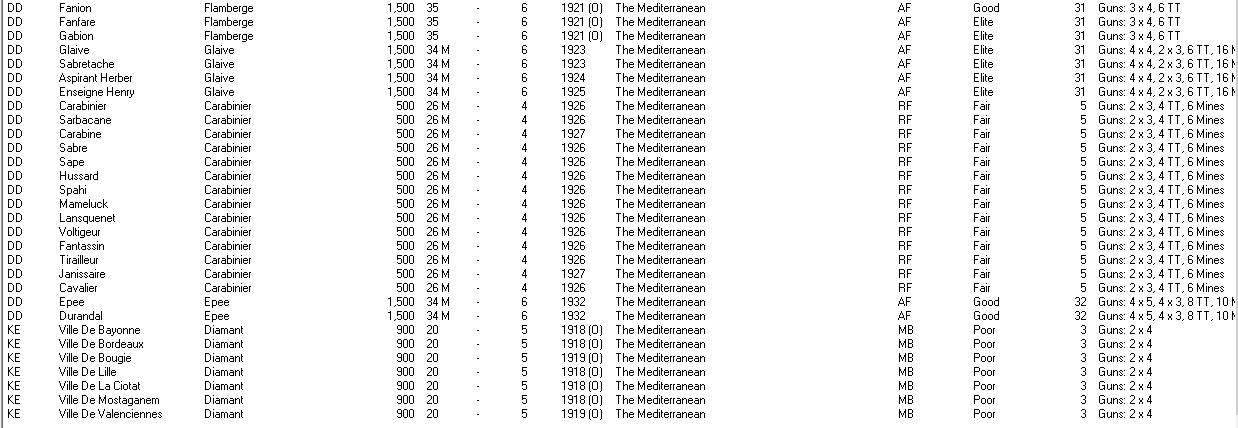It is embarrassing that I never thought to do that.
February 1923
The new-model German light cruiser Thetis is broadly equivalent to our recent light cruisers, though granted with added anti-air firepower and minelaying capability. (Our next European-service light cruiser will have those issues corrected.)
March 1923
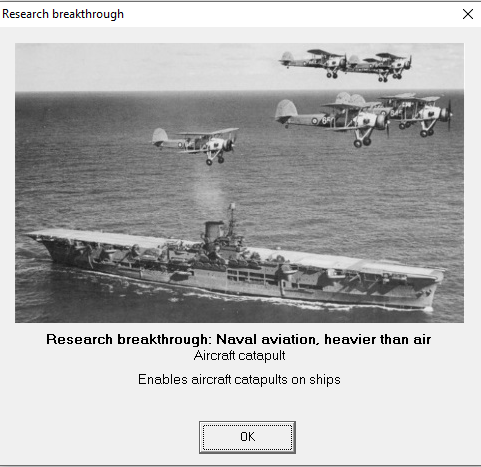
This will let us build a better seaplane tender, one which doesn’t have to stop to launch a seaplane, as well as build cruisers (potentially even light cruisers) with the ability to conduct seaplane scouting.
Currently, our doctrinal preference is to use seaplanes for scouting over torpedo bombers or dive bombers. This will save us ten or fifteen planes for strikes, when the time comes for that, but float planes are slower and less reliable than wheel-equipped carrier aircraft. Something to consider in the future.
April 1923
Loire loses its place as the provider of fleet torpedo bombers.
Because we got dinged for not building enough destroyers, I elect to rebuild Requin (the last and best of our 12" gun ships) instead of starting a new Ocean-class. This will bring her up to 25 knots, fast enough to hang with Ocean. Hopefully, when the rebuild’s done, we’ll have the budget in hand for a new Ocean follow-up.
May 1923
After a long, long wait, we’ve finally worked out how to do double gun mounts on a light cruiser. That might call for a new class—superfiring double turrets will give us a broadside advantage on known enemy light cruiser designs.
July 1923
Commandant Teste’s replacement in the build order will be a light aircraft carrier. Why that, instead of a seaplane carrier? Well, this carries 24 aircraft to Teste’s ten, mainly. Split evenly between fighters and torpedo bombers, it’ll be a better scout and be able to provide a CAP over the fleet.
No catapults, but it’s just large enough so that we won’t lose the ability to operate planes with heavy load from it. (That cutoff is, I believe, 10,000 tons.)
August 1923
On the plus side, at least for interesting gameplay notes, another naval treaty is signed, limiting us to 30,000 tons displacement and 15" main guns for 8 years. On the minus side, it really tanks our budget.
For comparison, Ocean is a 30,800-ton ship with 14" main guns.
November 1923
The new budget is a real kick in the teeth, doubled in intensity by our invention of quality-0 16" guns so soon after the naval treaty. The building program will, alas, be somewhat reduced.
March 1924
Somewhat delayed by the treaty budget, the first Arromanches-class carrier hits the shipyards. In four months or so, we’ll be in position to try an Ocean-class follow-on, budget-wise.
July 1924
Suffren, our next in the Ocean series of battleships, goes into the design studios. She’s almost identical to the Ocean class, but drops a half-inch of belt armor and a few secondary guns in exchange for torpedo protection 3 and fitting in under the weight limit.
November 1924
Project ‘annoy Austria-Hungary into a war they can’t win’ proceeds without a great deal of success.
It does make us enough money to pay for Suffren and a destroyer, at least.
December 1924
Britain’s working on an interesting cruiser. High speed, light armor, light weight.
January 1925
The middle way in an African crisis puts us in a good position financially. Rather than decide what to spend it on myself, since we’re right at the end of an update, I’ll put it to a vote. Read on.
Plans and Intentions
Tensions are low-ish across the board, with Austria-Hungary and Germany taking the lead at about halfway up the to-war meter.
Currently, we’re running a surplus of 1,352 funds per month, with three ships under construction: a Glaive-class destroyer, our first Arromanches-class light aircraft carrier, and Suffren.
That surplus is enough to do one of three many things, in combination with what we have in the rainy-day fund:
-
Rebuild the Redoubtables, our 1913-era battleships, with modern fire control, anti-aircraft guns, and 25-knot speed, one at a time. That would give us a decent 24-knot battle line,
-
Build another two of the new Condillac overseas-service cruisers. That would save us a little bit on maintenance as we pull older ships out of service.
-
Build some destroyers. We have a good number already (third-most in the world, and many more than our standard competitors Germany, Italy, and Austria; we don’t have many corvettes, though).
-
Potentially in concert with building destroyers or a Condillac, update the submarine fleet. We’re quite a bit behind in submarine count.
-
Build another aircraft carrier.
-
Build a new fleet-service light cruiser, with a burly dual-purpose secondary armament for maximum future-proofing.
-
Improve our air bases on the Channel Coast to help in future wars with Germany.
-
Something I haven’t thought of at all.
What should it be?
Option 4. Boring but sensible.
January 1925
The votes are in, and it looks like we’re building, in about this order:
-
A Condillac.
-
Some submarines.
-
A fleet service light cruiser, once money is available (i.e., after Arromanches finishes building.)
-
Another aircraft carrier, if it’s still within the scope of this update.
It’s a star-studded cast of names. Our Condillac is named Descartes, and our four submarines are Foucault, Volta, Bernouilli, and Ampere.
February 1925
Italy’s newest heavy cruiser is an overmatch for our own. Granted, we only built ours because of that brief naval treaty before Italy decided it was time to get punchy.
March 1925
French engineers invent the transverse arrestor wire, and duly simplify the installations on our existing aircraft carrier.
I believe this is a few years in advance of history. The earliest arresting cables ran, if I’m reading these histories correctly, fore and aft along the deck, spaced about 9 inches apart and suspended a foot or so above the deck on leaf springs (like modern, transverse arresting gear). The purpose was less to slow planes down—they were generally small and light enough that speed wasn’t a problem—and more to keep them from being blown over the side by gusts of wind. When the plane landed, hooks on its landing gear would engage the wires and guide it in a straight line to a stop.
USS Langley originally had both longitudinal and transverse wires, but got rid of the former in 1927. USS Lexington and USS Saratoga, both commissioned as aircraft carriers in 1927, were built from the outset. The French, on their sole historical aircraft carrier Béarn, also commissioned in 1927, used a modern transverse system as well.
April 1925
Good news, everyone! A minor crisis with Great Britain, which doesn’t even push our tension with them from green to olive, means we’re swimming in cash. Time for that new light cruiser design, I think.
The Voltaire class of light cruisers hit 30 knots, and feature light armor, a large torpedo armament, eight six-inch guns in four double turrets, a selection of mines and anti-air guns, and eight dual-purpose secondary guns.
I’d hoped to get them up to the same speed as Italy’s forthcoming heavy cruisers, but it wasn’t in the cards.
June 1925
Two Voltaires go into production: Voltaire and d’Alembert.
Also, it’s June, and war still looks pretty far off, so let’s try a fleet exercise! We’ll even let this one stand without savescumming, unlike the last one.
On the Red Team (us), we have Amiral Charner and Commandant Teste, two light cruisers, and three destroyers. On the Blue Team are Ocean and Requin, along with a mirrored supporting force.
The mission starts at 4:24 p.m., which is not an ideal timeframe for our aircraft carrier.
4:35 p.m.
Floatplanes launch from Commandant Teste, while Amiral Charner prepares a strike. If we spot the enemy soon enough, we’ll try one.
5:10 p.m.
Two scouting reports put the enemy in approximately the same place. Time to launch!
I end up launching Commandant Teste’s extra floatplanes loaded down with bombs, too. Can’t hurt!
5:22 p.m.
Here in the Air Formations window, you can see our various aircraft preparing to fly—Amiral Charner’s torpedo bombers will be spotted to the deck in 12 minutes (they were readied in the hangar but not lined up for takeoff, to avoid crowding the deck).
The fleet turns to the northeast to keep distance between themselves and the enemy fleet.
5:41 p.m.
Thirteen torpedo bombers are in the air. Commandant Teste’s launch operations are a bit more complicated, involving cranes, stopping to put planes into the water, and the like, so that element of the strike will be a bit later.
6:00 p.m.
Teste launches her seaplanes. Since it’s summer in the Bay of Biscay, dusk isn’t until 8:20 or so. We’ll still have daylight for aircraft recovery, an important factor.
6:30 p.m.
The aircraft we launched at the floatplane scouting report reach the scouting report’s location, circle for a bit, and set off on something of a search pattern.
6:37 p.m.
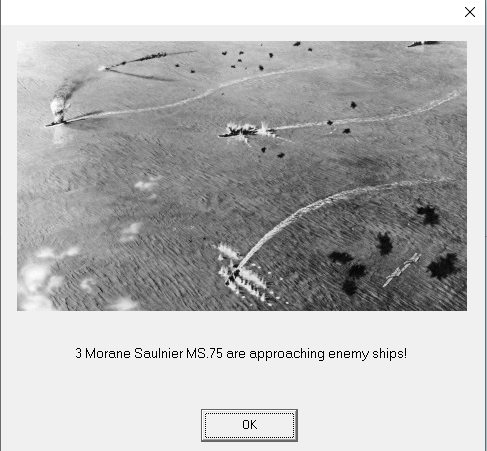
Those are the floatplanes, but the torpedo bombers are, according to my map, in the same area. (I’m not sure if fog of war applies to the reported position of friendly aircraft, but it would be just like this game if it did.)
6:46 p.m.
The torpedo bombers find the enemy, and all thirteen start their attack run.
6:50 p.m.

Two torpedoes hit one of the enemy ships. A few more aircraft remain to take their shots. A third hits a minute later.
7:13 p.m.
Returning strike aircraft report one battleship heading south, instead of the two the enemy started with. We won’t know until after the exercise how well we did, but we might have got one.
I don’t think there’ll be time for a morning strike, but I’ll be staying in the area just in case I can get aircraft off the deck before the end of the scenario.
8:20 p.m.
Twilight arrives, just as the last of the day’s CAP lands on Amiral Charner.
10:07 p.m.
Let’s see. 344 minutes of 800 in the scenario elapsed, dawn in… 330 minutes. Looks like meat’s back on the menu, boys!
3:38 a.m.
Twilight’s right around the corner. Soon, scouts will be in the air, so I’d better work out my plan.
The enemy is, I think, thataway. If they ran for the coast (that is, a port, although none are technically available in this exercise), I don’t care. I don’t think they got around behind me into the Celtic Sea, so I’m not spending aircraft on scouts in that direction.
I don’t remember quite what the rules are for ‘planes in the air’, so we’ll see when it cuts me off.
5:43 a.m.
Evidently, it’s ‘planes in the air with the enemy in sight’ as the cutoff rule. Oops.
Anyway, it also turns out that your floatplane carriers won’t launch scouting missions if their air wing’s mission has been set to something other than Recon, like it was when I used them for an air attack.
In the final reckoning, we get Ocean with one torpedo and Requin with two, causing light damage to the one and medium damage to the other. Not bad, for 1920s technology, but not a reason to cancel the battleship program altogether, either.
On the plus side, Ocean, Requin, Amiral Charner, and Commandant Teste are all now Elite-skill ships, and the exercise made Austria-Hungary a little touchy.
January 1926
Holy long delay, Batman! The second half of last year was boring, though, so you didn’t miss much.
-
Arromanches entered service, and her successor is now under construction.
-
I took a 15-destroyers deal, on the theory that I can build a modern, cheaper replacement for the old Fauconneaus I rebuilt as pseudo-corvettes with improved features—in particular, minelaying. The new Carabinier class is slow at only 26 knots, and unlikely to see any duty beyond trade protection, but advanced technology and extra depth charges make them better sub-chasers, and the aforementioned minelaying ability will give us an edge in tight seas (such as the Mediterranean and North, where we spend most of our time.)
June 1926
Holy long delay again, Batman! The first half of this year was more boring than the last. The only happening of note was our development of motor torpedo boats.
July 1926
We learned how to make medium bombers a while ago, and Dewoitine has a doozy of a prototype for us:
Longer range than our flying boats by a long shot. They’ll make good land-based scouts going forward. I start a new request for torpedo bomber prototypes. Ours are looking a little long in the tooth.
January 1927
I must have missed our development of full-size CV conversions (or we skipped that technology; see research note below), because we just developed full-size CVs. The first aircraft carrier you build has to have substantial gun armament, because naval design bureaus are unimaginative. To get that out of the way, I’m building a one-off.
Named after France’s historical interwar carrier, Bearn (well, Béarn, but I don’t know if the game can do accented characters) carries a 46-plane air wing and no catapults. (The ones pictured I added before hitting the ‘check design’ button; we haven’t worked out aircraft catapults on carriers yet.) 30-knot speed should keep her out of trouble. Along with her 6" main guns, she has a large battery of dual-purpose 3" secondary guns in double turrets (another new research item), and passable AA machine gun armament.
Her flight deck and hangar sides are armored, an important consideration in tight seas. TODO: discuss.
Research note: some technologies in Rule the Waves 2 are marked as skippable—your scientists may simply move on to the next technology. Taking a quick look at the wiki, CV conversions are indeed in that category.
Reports, Plans, and Intentions
Finances (and Shipbuilding)
Nine months from today, we’ll have a free construction budget of 8,538 funds per month. 2,500 or so of those will go toward building Bearn. 3,500 or so are probably earmarked for the next battleship in the Ocean-Suffren series (which will be another incremental improvement of very similar design).
So, it’s time for another priorities question! What do you think is important as we careen toward the 1930s?
-
More Voltaires. I have another eight names lined up for ships in that series, and they’re currently the only non-destroyer ships in French service that can keep up with our newer carriers.
-
More battleships. We can probably swing two of the next class in line, or perhaps one of those and one 30-knot battlecruiser as a heavy escort for the carriers.
-
Heavy cruisers. As always, we’re behind in this race. The difference this time is that we don’t have a large fleet of battlecruisers capable of running them down and defeating them.
-
Battleship updates. The money’s there to make that 25-knot battle line I keep talking about.
-
More airbases on land. Our shiny new medium bomber is coming soon. It would be good to have some of them to throw around, especially given rising tensions with Austria-Hungary, who we can nearly bottle up by building more bases in Greece.
One thing to note: our fleet is no longer the fastest on the seas. We’re not the slowest, but we’re definitely middle of the pack nowadays. On the other hand, our two early-20s cruisers are much, much more heavily armored than enemy heavy cruisers, an edge we may be able to press in a war.
Diplomacy
Speaking of rising tensions with Austria-Hungary, we could finally be getting the war we wanted from the start. Tensions with the Austrians are twice as high as everyone else, and on the border of yellow and orange. If we push them, we can get them into a fight, I bet, starting with cranking up spying to high.
Prestige
Sitting pretty at 48.
Love this write up! Based on this I bought RTW 2 and am puzzling my way through it. Lots I still don’t understand.
Could you give us a summary of what you know about the Austro-Hungarian navy? Naturally it is still far inferior to the glorious French navy, but there might still be areas we can bolster to minimise damage.
How did the Italians manage to make that heavy cruiser so speedy? Is it lacking armour?
That fast battlecruiser sounds like a useful vessel. Other than that it certainly feels as though your battle line has been becoming gradually obsolete. While it might not be necessary against Austro-Hungary, a speed upgrade could certainly help there.
Update your old battlwagons where practical. Make those airbases happen. Those medium bombers shall rule your Mediterranean. Can they carry torpedoes?
Those cruisers are nice, you need those too. I would rate new battleships and cruisers as least desirable in this new age of small and fast or hidden torpedo delivery systems like planes, MTBs and submarines.
I hope you enjoy it! There’s a good bit I don’t understand either. As wargames go, it’s relatively playable if you just do the historically-appropriate thing.
Regrettably, they can’t. Once they can, I can get rid of the torpedo bomber squadrons on land airbases and go with a fighters-medium bombers force structure.
Yes. Our Montcalm class (the first one entered service in 1919) is four knots slower than the Italian cruiser pictured, but has twice as much belt armor.
Dossier: Austria-Hungary
Naval budget: 227,150 per year (France: 340,000)
France’s war victories and relatively ascetic approach in the matter of taking colonies as spoils makes for a serious budgetary edge.
Battleship tonnage: 159,800, 4 ships + 2 under construction (France: 201,900, 7+1 ships)
Currently, Austria’s battleships are about as new as France’s. Over the course of a two-year war, Austria will gain a slight edge.
Battlecruiser tonnage: 89,000, 4 ships (France: 47,200, 2 ships)
Three of Austria’s battlecruisers date to the early 1910s. France’s two ships are due for a rebuild—they’re lightly gunned by modern standards with 9x12" guns, but their armor is good, and I can push them to 29 knots when they go back into the docks.
The Lyon class, our 6x15" battlecruisers from 1912, could also be turned into battlecruisers, in particular if I replace their 15" quality-1 guns with roughly-equivalent 14" quality-0 guns. That’s a much more expensive project, though.
Aircraft carrier tonnage: 0 (France: 35,100, 2+1 ships)
France has the edge here, and also in aviation generally, with slightly fewer than twice as many planes as Austria. (Granted, France’s aviation is more spread out than Austria’s.)
Heavy cruisers
France’s heavy cruiser force, though small, is better-equipped than Austria’s—the Montcalms are larger than their new heavy cruisers and newer than their big heavy cruisers.
Light forces
French light cruisers have the edge over the Austrian vessels in both number and quality.
Austria has only a few modern destroyers, but they’re very well-equipped: depth charge projectors, lots of anti-aircraft armament, and double turrets (an innovation we haven’t yet uncovered). Given their apparent advantage in destroyer technology, we’ll have to be careful of their torpedoes.
Submarines
They have 50 to our 20, and many of theirs are medium-range. (France is sticking with coastal submarines—their job is more to patrol the Mediterranean coasts and torpedo enemy warships more than it is to destroy large amounts of merchant shipping.) Happily, we have a large fleet of obsolescent and obsolete destroyers to task with hunting submarines.
January 1927
So, based on voting and my own intuition, here’s what we’ll be doing construction-wise this update.
-
Bearn, our first full-size aircraft carrier.
-
The next Ocean-Suffren-type battleship.
-
A 30-knot battlecruiser or heavy cruiser, to provide some punch against enemy ships of the same time and ensure our aircraft carriers have protection against heavy surface forces.
-
New airbases in Bizerte, Tunisia, and Kalamata, Greece, along with re-equipping our flying boat squadrons with medium bombers.
Of the designs I can come up with, the heavy cruiser seems to make the most sense—I can get a capable 32-knot ship for a reasonable price.
The Latouche-Treville class mounts nine 9" guns as its main armament, along with dual-purpose 4" secondaries in twin turrets (a new innovation). Her armament will stop 7" guns, so she’s an overmatch for any light cruisers she can catch, and she carries a pair of seaplanes with seaplane catapults, allowing her to serve as a fleet scout when the carrier becomes a primary tool in our toolbox.
February 1927
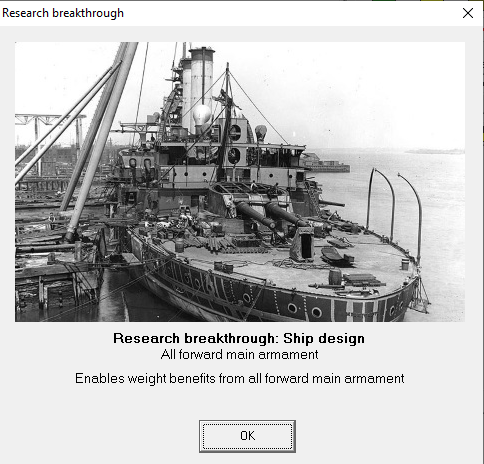
Why is this good for us? Well, on the surface, because our battleship designs have featured an all-forward main armament already. A bit deeper, because mounting all your heavy guns forward allows you to make your armored citadel shorter, which saves weight on armor. The next battleship design’s scheduled for summer. We’ll see what it buys us then.
March 1927
More opportunities to tweak the Austrians! I’ll take it.
Our new medium bomber enters service, which means I’ll have to slowly and laboriously change a bunch of air groups around. I haven’t done a game with a lot of land-based air before. I wonder if I’m missing some feature in the UI that makes this easier.
With an awful lot of money free, I start on another of our projects, rebuilding the Lyon-class battleships to slightly more modern standards.
April 1927
The second Voltaire-class light cruiser enters service. They’re capable ships. It’s a shame there’s only room in the budget right now for the two we have.
If war breaks out, we’ll have a chance to build a few more, I suspect.
May 1927
All-forward main armament buys us a few features: more secondary guns, more rounds per main gun, and crucially, another knot of speed. In the grand tradition of naming these after our old pre-dreadnoughts, meet Courbet.
June 1927
The fleet sails for the Mediterranean to counter aggressive exercises by Austria.
July 1927
Blueprints for an under-construction Austrian battleship—the most precious of spy data. It’s strictly inferior to our own modern ships.
Suffren enters service, and will be joining the fleet in the Mediterranean soon.
August 1927
The Prime Minister wants more battleships. I take the deal, on the theory that we’ll be at war with Austria soon enough that there won’t be time for the fact that I’m not going to hold up my end to come back to haunt me.
October 1927
Who called it? War is declared, after Austro-Hungarian saboteurs blow up a French destroyer in Brest.
The first battle of the war is a destroyer raid; a number of our corvette-destroyers are in action, because I haven’t had time to set them to trade protection yet. The plan is more or less to run toward port and leave the field to the Austrians, unless there are fewer of them than I expect.
There is, regrettably, little fighting to be done. This is where the Austrians are better than we are. It still comes out as a marginal victory because they elect not to get stuck in, abandoning the bombardment target which was their objective.
November 1927
This month’s battle is a convoy defense. The convoy is well to the west, but the Austrians have caught us in an interesting position. North of the sighted ship is our carrier force—Amiral Charner and Arromanches. South is a trio of screening light cruisers. West are Ocean and Suffren, our new modern battleships.
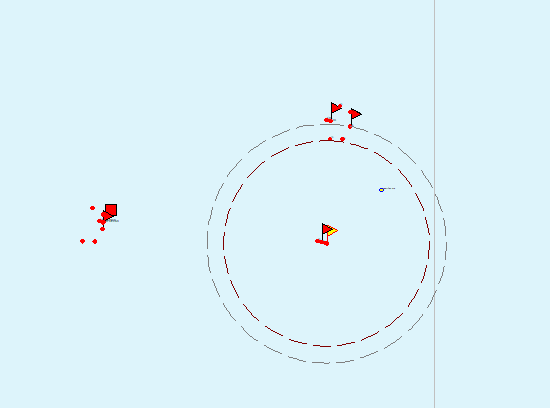
Our medium bombers are in range of the enemy. It’s 1:36 p.m. on a blustery day; sighting range is limited, but air operations are possible, and when the carriers turn into the wind, they’ll be heading away from the enemy. They immediately begin to prepare a torpedo bomber strike.
Dusk comes in three hours.
1:43 p.m.
Another ship appears to the north of the carriers; they’re sandwiched. Both ships, however, are destroyers.
2:40 p.m.
Although our new light cruiser d’Alembert takes a torpedo hit, she has (unusually for a light cruiser) substantial torpedo protection, and weathers it like a champ. Our light forces may not be quite up to Austrian standards, but three light cruisers and six or eight destroyers are perfectly sufficient to force the Austrians back.
The carriers get some reconnaissance aircraft in the sky, following the destroyers as they run north, and turn south, to hide behind the battleships.
4:40 p.m.
The recon planes fan out from the carriers to the north, passing the Austrian destroyers (fleeing north) and turning back as dusk approaches. They don’t spot anything else.
1:56 a.m.
So, imagine my surprise when the scenario ends and I see an Austrian force not twenty miles from my own.
The Austrians were just north of my searching planes (which had gone a little ways past the dots representing the destroyer sightings) when they turned back, shortly before 4:00 p.m. If the Austrians had been twenty minutes faster, we probably would have spotted them, and therefore known they were out there.
December 1927
This one’s a wash. I decline battle with the Austrian destroyer fleet in the Adriatic, the Austrians decline to attack a convoy in the Atlantic protected by Montcalm.
January 1928
Austrian submarines sink a French destroyer and one of our older seaplane tenders. A battle between an Austrian heavy cruiser and a French light cruiser ends inconclusively. The Austrians break off the fight as night approaches.
February 1928
We get some back, sinking a submarine, thwarting several patrolling Austrian raiders, and intercepting a raiding light cruiser.
The light cruiser Surcouf, of the Lavoisier class, approaches a target steaming about midway between Mers El Kebir and Murcia, Spain.
It’s the sole Austrian Jupiter-class light cruiser, their largest and best example of the type. She has more guns than Surcouf, but Surcouf’s guns are high-quality 6" numbers against the Austrian 5", and Surcouf has better armor to boot. We’ll see if we can ring Jupiter’s bell enough times to slow her down to Surcouf’s speed.
Over the course of the battle, Jupiter gets very lucky. Although she scores only 8 hits to Surcouf’s 14, Jupiter’s last hit disables Surcouf’s electric generators, slowing her down and giving Jupiter time to escape.
Not, however, for very long. One of our submarines, lurking nearby, torpedoes Jupiter and sinks her as she flees the scene. It goes into the books as a major French victory.
March 1928

Well, that wasn’t quite the ending I expected. It was such a quick war that we didn’t even get any serious reparations out of it. Bit of a waste, truthfully, and now we have to deal with the postwar budget malaise.
April 1928
I make the tough decision to scrap Amiral Charner. She’s slower and less capable than our two purpose-built light carriers, and aircraft aren’t quite the deciding factor yet they will be in the future.
July 1928
Dewoitine comes up with an improved version of their medium bomber, which adds 15 knots of speed and 30 miles of range. It doesn’t take me long to decide that yes, I want to buy that.
October 1928
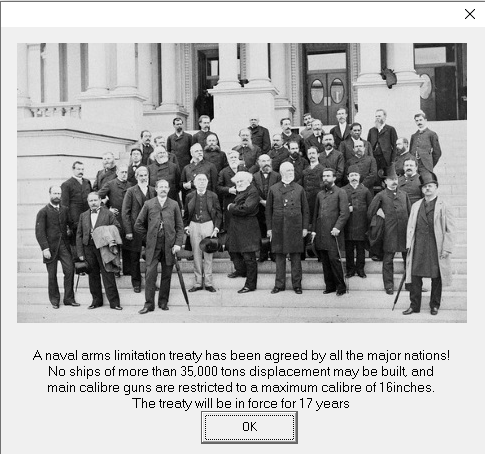
I wasn’t for it, but France signs another naval treaty. The limitations on this one are a bit less restrictive—35,000 tons, 16" guns—but the concomitant budget hit means I’m going to have to delay or cancel some projects.
November 1928
An improved torpedo bomber enters service, nearly identical to our current model but with slightly longer range and slightly better speed.
In technology news, we’ve unlocked AA directors (which improve the accuracy of anti-air guns, and should be refit onto our ships as we have time) and triple turrets for light cruisers, which should make for some designs with better weight efficiency.
January 1929
We come to the end of another update, tragically much shorter than I had hoped it might be, given the joys of wartime budgets.
Fleet Report 1929
I haven’t provided a full picture of the fleet in some time, so I thought I’d do so in this update.
Battleships
-
Devastation, built in 1910 and rebuilt in 1916. 22 knots, 8 12" guns in four double turrets, including wing turrets with cross-deck fire. Mothballed. Candidate for retirement.
-
Lyon, built in 1912 and rebuilt in 1927. 26 knots, 6 15" guns in three non-superfiring centerline turrets. In reserve.
-
Marseilles, a Lyon-class battleship built in 1912 and rebuilt in 1916. 24 knots, 6 15" guns. Mothballed. Candidate for rebuild to 1927 spec (12 months, ~2300 funds per month) or retirement.
-
Redoubtable and Marengo, Redoubtable-class battleships built in 1913 and rebuilt in 1917. 22 knots, 10 12" guns in four non-superfiring centerline turrets. In mothballs.
-
Requin, built in 1915 and rebuilt in 1923. Our first fast battleship. 25 knots, 12 12" guns in four superfiring turrets. Active.
-
Ocean, built in 1923. First in our line of modern battleships. 26 knots, 8 14" guns. Active.
-
Suffren, built in 1927. 26 knots, 8 14" guns. Active.
Battlecruisers
- _Rouen and Nancy, Rouen-class battlecruisers built 1915 and 1920. 27 knots, 9 12" guns. Candidates for rebuild (would push speed to 29 knots, add AA armament). Active.
Heavy Cruisers
- Montcalm and Bruix, Montcalm-class cruisers built 1919 and 1920. Slow for their role. 27 knots, 12 9" guns. Candidates for retirement? One active, one in reserve.
Light Cruisers
-
Three Chateaurenault-class cruisers, built 1903-1905. Designed for cheap foreign service. Badly obsolete, but cheap to maintain, and they fill tonnage requirements overseas where most of our preferred opponents have no presence. 24 knots. 10 4" guns. Active.
-
Two Pascal-class cruisers, built 1910. Also obsolete, but also filling tonnage requirements. 24 knots, 8 5" guns. Active.
-
Two Lavoisier-class cruisers, built 1916-1917. 27 knots, 8 6" guns with a 6-gun broadside. Might benefit in terms of maintenance costs from a rebuild, but a bit too old-school in design terms. In mothballs.
-
Five Troude-class light cruisers, built 1917-1919. 28 knots, 8 6" guns with a 6-gun broadside. Similar situation to the Lavoisiers. One in mothballs, four active.
-
Four Condillac-class light cruisers, built 1924-1926. Exclusively for foreign service. 28 knots, 6 4" guns, 6-gun broadside. Active.
-
Two Voltaire-class light cruisers, built 1927. Some of the best in the world, with mines, torpedo tubes, an all-centerline armament, and a dual-purpose secondary battery. 31 knots, 8 6" guns. Active.
Aircraft Carriers and Seaplane Tenders
-
Commandant Teste, seaplane carrier, built 1923. 27 knots, 10 aircraft. Active.
-
Arromanches and Dixmude, light carrier, built 1925-1927. A bit slow, but still capable enough to keep on the books for years to come. 28 knots, 24 aircraft. Active.
Destroyers and Corvettes
-
Five miscellaneous obsolete destroyers, rebuilt 1919-1921 to serve as corvettes. In mothballs.
-
16 Harpon-class destroyers, built 1915-1919. Obsolete by the game’s reckoning, but still reasonably efficient by the standards—speed and torpedoes—by which I judge destroyers. 33 knots, 3 3" guns, 4 torpedo tubes. Active.
-
Seven Flamberge-class destroyers, built 1921. 35 knots, 3 4" guns, 6 torpedo tubes. Active.
-
Four Glaive-class destroyers, built 1923-1925. 34 knots, 4 4" guns, 6 torpedo tubes, 16 mines, anti-aircraft guns. Active.
-
Fifteen Carabinier-class destroyers, built 1926-1927. Built to serve as corvettes, in place of a similar number of obsolete 500-ton destroyers from the turn of the century. 26 knots, 2 3" guns, 4 torpedo tubes, 6 mines. In reserve.
-
Seven Diamant-class corvettes, built 1918-1919. 20 knots, 2 4" guns. In mothballs.
Comparison
Here’s the national-comparison almanac page, so you can see how we stack up.
Plans and Intentions
In out-of-character news, the game’s been updated to version 1.18, which has a number of changes of various impact. It also has an improved and updated manual, and a change to the order of events in a turn so that I can adjust ship statuses before the first battle in a war. Put another way, the first battle in a war (except for surprise attacks when Japan’s involved) happens on the month following the outbreak of the war.
Budget
This is where things get tough. With some extremely aggressive mothballing and reserve-fleeting, here’s how our budget looks right now.

That is, we have about 6,500 funds per month. What does that buy? Some combination of the following.
-
4,000-4,200: an advanced battleship (see below, under Ship Design). ~36 months.
-
3,500: a standard battleship (like our existing series). ~36 months.
-
2,700: a heavy cruiser. ~24 months.
-
2,550: an aircraft carrier a la Bearn. Future carriers will carry more aircraft, because they’ll be free of the requirement to have cruiser-style guns. ~24 months.
-
2,500: a rebuild of an existing battleship to use up-to-date machinery and add anti-aircraft capability. ~12 months.
-
1,550: a light cruiser a la Voltaire. ~18 months.
-
350: a destroyer a la Glaive. ~12 months.
There are four ships in the dockyards right now: Courbet, a standard battleship, Latouche-Treville, a heavy cruiser, Diderot, a light cruser, and Bearn, an aircraft carrier. Courbet and Latouche-Treville are paused for money reasons—we don’t have enough surplus to resume construction on either one right now.
Diderot and Bearn will be complete in six months, which will free up just enough budget to finish Courbet and Latouche-Treville. Assuming that’s what we do, Latouche-Treville will enter service in mid-1930, and Courbet will arrive right around the next update in early 1931.
Ship Design
The new treaty is the limiting factor on battleships again. We could make either a 27-knot, 16" battleship within the treaty limits (~4000 funds per month), or a 30-knot, 14" battleship (~4200 funds per month).
Or, we could continue to build existing budget battleships, like the ones we have now, and focus on other ships. Our destroyer force is weighted toward old ships right now, and it always seems like we need more light cruisers than we have.
What Next?
I didn’t ask any direct questions above, on the theory that there’s enough information that some ideas might be coming to you already. Are they? If so, what do you think we ought to do? How should we prioritize ships over these next two years, given our budget constraints? What should we do with the ~2,000 funds per month we have on hand now?
How’s your destroyer tech? Does it make sense to start building ones that straddle the line with light cruisers? Might be cheap and give much bang for your buck…
Just to confirm… in this reality: World War 1 never happened, right? Do you have any idea if a massive conflict is possible/likely? I think the biggest war I’ve seen you encounter was either 2v1 or 2x2.
Collating all the feedback as usual, I have four recommendations:
- Rebuild an old battleship or two. I’m going to rebuild Marseilles, on the basis that our battlecruisers were always heavily armored and can be brought up to the speed of our new battle line much more readily. I may do one of the Redoubtables, or I may put them on the scrap heap. Devastation will probably go soon too.
- Update our light forces some, as I’m able. A Glaive-alike won’t be too too spendy, and will help us move away from the obsolete Harpons.
- Build to treaty limits for the next battleship. It’ll be expensive, but intentionally building a second-rate battleship is risky.
- Build the next aircraft carrier bigger, to get a proper 1930-ish air wing of 70 to 80 planes.
And we’re off!
February 1929
We now have advanced gun directors for our ships, making them yet more accurate, and meaning we have to install them on yet more ships. I think I might pop them onto the Rouen-class battlecruisers first, since they’re now marked obsolete.
April 1929
Bearn enters service. Because we still, evidently, haven’t unlocked the secret to building our own dive bombers, I buy a license to build the British Gloster Goblin. Bearn’s air wing is nine torpedo bombers, 18 dive bombers, and 19 fighters. Not bad. Maybe we’ll try another exercise this summer, or in summer 1930.
October 1929
Having asked for a new fighter a few months back to match our new torpedo bombers, I pick a new one which can match our torpedo bombers and dive bombers for range.
December 1929
In the last two months, I traded a bit of prestige for a bit of budget, and a bit of tension for a bit of prestige. Worthwhile, in the end, although we are also tweaking Britain slightly.
We make an important advance in fleet tactics: in large battles, aircraft carriers will operate in their own force, meaning that a) I can control them directly even if they’re out of sight of the battleship force’s flagship, and b) they’ll start well out of the way of the enemy, generally.
March 1930
A colonial crisis with Great Britain leads to increased tensions, but also massively increased budget.
I use it on Joffre, a new aircraft carrier.
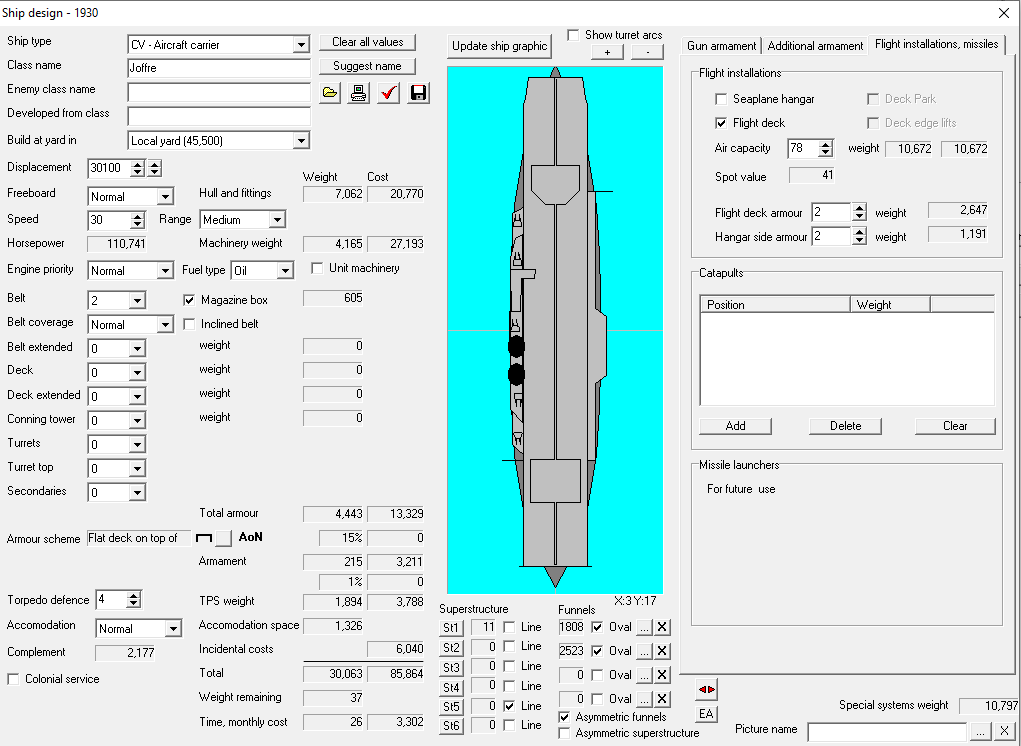
She’s not the fastest of carriers, but with a 78-plane air wing, she is quite a capable one.
We’ll lay down the first ship in five months.
May 1930
Or perhaps a bit later than that. A new liberal government takes over, slashing naval budgets. (Happily, not slashing naval budgets too much.)
June 1930
I can just fit the rebuilds of Rouen and Nancy (to use advanced director fire control) in before Courbet and Marseille leave the yards, which I elect to do.
That way, it’ll be October, and I’ll be able to reserve some money the use of which we can discuss prior to the next update.
August 1930
Since we have a pile of money sitting around, I upgrade some of our strategically-important airbases to 60-plane capacity. That group includes the one at Dunkerque, which is well-sited for wars with potential North Sea foes Britain and Germany, and the ones framing Italy and Austria-Hungary in the Mediterranean.
December 1930

If you scratch the politicians’ backs, they’ll scratch yours.
Some of the money goes toward equipping some new squadrons on our new airbases. I’m reserving the rest until next month.
January 1931
Another uneventful update passes.
Plans and Intentions
Tensions are highest with Britain and Austria-Hungary, at 4 and 5 (of 12 before war), respectively.
Budget
Our annual budget, 358,300 funds, is on par with Germany’s and only 20,000 less than Britain’s—our wars have been successful, between reparations and worthwhile colonies, at enhancing our monetary capacity to wage further wars.
We spend 8,863 funds per month on ship maintenance, 4,639 on aircraft maintenance (the French naval air service is the largest in the world), and 5,653 on other items, leaving a budget of 10,703 funds per month for construction.
Shipbuilding
At the moment, we’re building ten submarines and our new fleet carrier Joffre.
Ship Planning
We didn’t get a new battleship laid down this update, instead electing to rebuild three ships (Marseilles and the two Rouen-class battlecruisers) and lay down Joffre.
Obviously, that would be a good thing to remedy over the next two years. So, what manner of battleship will we be building? A 30-knot ship with 14" guns, or a 27-knot ship with 16" guns? (At present, our battle line is good for 25 knots, or 26 knots if we leave Requin behind.) That’ll account for around 4,000 funds per month.
Of our obsolete battleships, Marengo is the only one left. We could rebuild her to 26-knot speed, given 14 months at 2,300 funds per month, or we could scrap her. Scrap her or rebuild her? Note we have eight other battleships to Germany’s nine (although Germany also has eight battlecruisers to our zero, and we’re far superior to Germany in naval aviation).
Whatever we do with Marengo, we’ll have ten months or so at the end of the update during which to build some new ships. A thoroughly modern light cruiser, with triple turrets, anti-air armament, and room for a scout plane will cost us around 1,850 funds per month, while a modern destroyer with 5" guns, anti-air armament, and a huge pile of torpedo tubes will cost us around 450 funds per month. So, after Marengo’s rebuild (or in place of it), we could build five new destroyers at once, or one new destroyer and one new light cruiser. How should we update our light forces: more destroyers, or a destroyer-cruiser mix?
Finally, we have two 27-knot heavy cruisers on hand which date back to 1919 and 1920. They’re too slow to play heavy cruiser in the modern era. We could scrap them, or we could convert them to light carriers. In the latter case, they’d be able to carry 24 aircraft a pop, and we could bump their speed to 29 knots, for a 12-month/2,180-funds rebuild—effectively, two light carriers for the price of one purpose-built new hull. What should we do with the Montcalms?
So far the biggest one has been 2v1 the easy way. Big, apocalyptic wars aren’t so much within the game’s design—smaller, more frequent conflict better fits the ‘build ships, have them fight’ model.
I don’t think there’s a way to force a big WW1-style conflict.
I vote for the bigger guns.
Rebuild her. Don’t the the Marengo go to waste!
I vote for destroyers. Torpedos away!
Convert them into light carriers. Waste not want not and all that.
You had me frantically googling there.
What size bombs do the Goblins (Lutins?) carry? These are biplanes, right? Does the game model the planes to that detail?
@CF_Kane, one note on Marengo—she predates torpedo protection, so she’s as vulnerable to air attack as Lyon and Marseilles, without having the advantages of the latter ships’ 15" guns.
Alas, the aircraft types are as fictional as the ship classes—no relation to Glosters or Goblins of history. I believe these ones carry 250lb bombs at medium load or 500lb bombs at heavy load.
Looking at the game’s wiki, dive bombers are apparently not a guaranteed tech—there’s about a 10% chance we won’t develop them at all, and will have to continue buying production licenses.
Although the game doesn’t track biplane vs. monoplane, these are almost certainly biplanes—monoplane dive bombers are a mid-30s innovation, and monoplane carrier-capable dive bombers came a little later than that.
How carrier centric are our major enemies? If they are going heavy into planes, then I supposes the old girl might have served long enough. If not, probably still useful to have around.
I have to agree that the guns are more important. From what I’ve seen we will have the option to refit the engines later at not excessive cost, while the guns are stuck there. Also right now 30 knots does little for us when the rest of the line is travelling slowly.
Scrap her. She’s obsolete in more ways than just speed.
Destroyers.
We already lead the world in naval aviation. I’m not sure what a couple more CVLs would give us.
At the end of the last update, I asked four questions. Here they are again, with (the answers):
- Big guns or high speed for the next battleship? (Majority favors big guns.)
- Rebuild or scrap Marengo? (Approximately a tie, so I’ll break it: scrap her.)
- Destroyer-cruiser mix, or destroyers? (Destroyers win by a country mile.)
- Montcalms to light carriers? (Approximately a tie, so I’ll scrap one and carrier-ize the other.)
January 1931
Time to get some ship designs… designed.
In honor of the dear, departed Marengo, I name this new class of ships Marengo. 16" guns, AA directors, level 4 torpedo protection, and a seaplane hangar and catapult. Still only 27 knots against our ~30-knot carrier fleet, but she’s not so much slower that she’ll be entirely left behind.
Montcalm goes to the scrappers, while her counterpart Bruix becomes a 29-knot, 24-plane light carrier.
Our new destroyers will be called the Epee class. Because we haven’t figured out dual-purpose main guns or dual turret mounts on destroyers yet, they’re still notably inferior to their Austrian counterparts, but nevertheless a good followon to our existing Glaives. They are a bit spendy, though—two at once, for the moment.
April 1931
Catastrophe! Tensions are low, and Parliament votes to reduce naval spending. I think we’ll still be able to fit Marengo in, but it might scupper our plans for a fleet exercise this summer.
May 1931
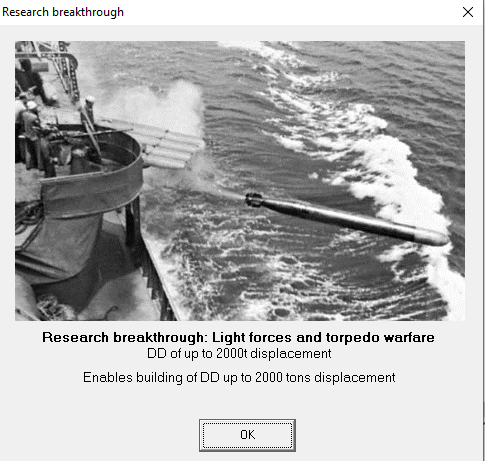
Ah, what timing, after we just designed a new class.
Honestly, though, I’m not inclined to redesign it until we have dual-purpose guns and twin mounts for destroyers.
French scientists also work out +1 quality 14" guns. Regunning Ocean, Suffren, and Courbet will make them much better ships at very little cost—4 months at 718 funds per month, plus a litle extra for Ocean and Suffren to retrofit better fire control.
July 1931
Blueprints for an Austrian cruiser suggest that our sole remaining cruiser is still superior.
In fleet tactics, we’ve figured out reliable voice radio, which will further reduce the likelihood of signaling errors during battle. We also develop improved arrestor wires, and buy a slightly longer-legged torpedo bomber from Dewoitine.
September 1931
The Navy League mobilizes against a new government attempting to cut naval spending, at the cost of very mildly increased tensions with Germany.
January 1932
Bruix finishes her rebuild and ten new submarines are launched this month, freeing up the budget for rebuilds of Ocean and Suffren to use the most advanced 14" guns and fire control available. (Suffren packs on some more AA, too.) In addition, there’s money for another pair of Epee-class destroyers.
August 1932
With money in the bank and no wars on the horizon, it’s time for a quick exercise.
Fleet Exercise 1932
The goal: see how well our heavily-armored and AA-gunned battleships can do against determined air attack. Ocean, Suffren, and Marseilles (the latter as a control) face off against Bearn, Bruix, and Arromanches, each side with small supporting forces.
It’s a nice day, and over the course of the first hour, recon planes take off and head for the horizon.
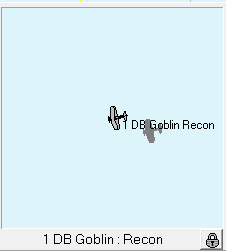
Answering a reader question, they are in fact biplanes.
Something I didn’t realize when I bought the Gloster Goblin license was that it’s relatively short-legged compared to our torpedo bombers. (The yellow circle against the purple one.)
Also of note in the preceding image: the enemy force has been spotted. The course and composition in the scouting report look good, so I’m going to gamble a bit on the whole report being high-quality and throw a Sunday punch at it.
That’s… 53 planes. Not our whole force (we can’t launch every plane without leaving some below deck and spotting them after the first wave launches), but not bad for 1932. They’ll be on target at around 2 p.m., against 12:55 right now.
Or sooner, maybe.
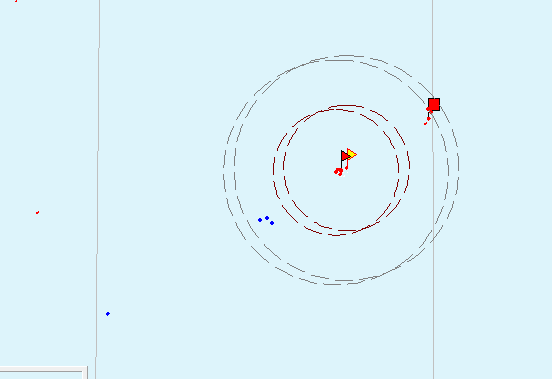
At 1:06, the screening light cruisers come across enemy light forces, then turn tail and run toward the carriers.
By 1:23, a number of planes are already in the air. (They’re going piecemeal, since I didn’t hit the ‘coordinate strike’ button, but I think that’s okay given that they aren’t facing any CAP. Also, we haven’t developed coordinated multi-carrier strikes yet anyway.)
At 1:36, a formation of 8 torpedo bombers and 9 dive bombers approach enemy ships. Four minutes later, I get the first results in the combat log.
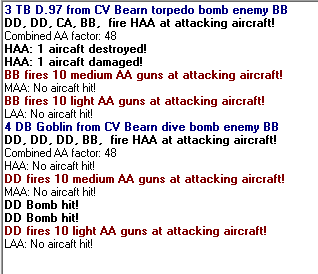
A few dive bomber hits on a destroyer, but withering AA fire from the dual-purpose guns on the battleships seem to blunt the torpedo strike pretty effectively.
By 1:46, the first wave seems to have wrapped up, with the AA guns the clear victors. The total score is three bomb hits, two on a destroyer and one on what the log reported as a battlecruiser—perhaps Marseilles?
At 2:15, aircraft begin returning. I ready them for a second strike.
It, and indeed the wargame as a whole, are the definition of inconclusive. The strike comes across what seems to be a dispersed enemy force, focusing more on the seaplane tender (Commandant Teste) accompanying the battleship force than any of the heavy units.
The final tally after two large strikes is one torpedo hit and two bomb hits, spread across Marseilles and Commandant Teste. (The reported hits on a destroyer must have been fog of war.) Teste took heavy damage, Marseilles took light damage.
Very few of the torpedo bombers made accurate launches, and the dive bombers didn’t obtain a great measure of glory, either. In Rule the Waves, light and medium AA are much more important for causing inaccuracy in attacking aircraft, rather than actually destroying them. That seems to be borne out by today’s results, and suggests that a retreat in carrier building over the next few years might be wise.
September 1932
The traditional upheaval in an African colony results in a budget bump and a rise in tensions. Austria might be the next war.
October 1932
Joffre enters service. Her air wing is 26 each of fighters, torpedo bombers, and dive bombers.
Her completion, along with an increase in budget from the rising tensions with Austria, permit me to lay down a second Marengo-class battleship—the first time we’ve had two battleships under construction at the same time in almost two decades.
January 1933
Austria-Hungary has seized a colony, and not just any colony, Morocco. This cannot stand! That’s our northwest-African slice of the pie!
In less affronting news, we can now build destroyers with twin turrets.
Status: Image Dump Style
I’m a bit behind already this week, so it’s going to be light on analysis and heavy on information.
Finance and Diplomacy
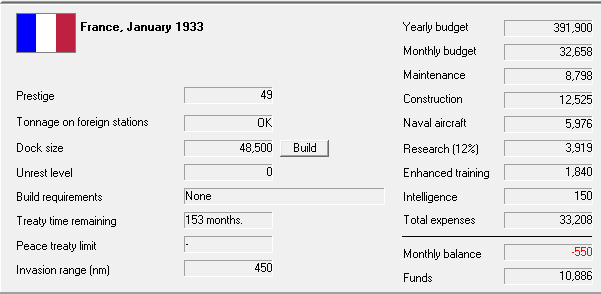

Naval Comparison
The Fleet
Shipyards
Plans and Intentions
I think it’s obvious that we should go to war with Austria and take Morocco from them—it’s an affront that they have it in the first place.
Beyond that, it seems like the question is, should we go all-in on air power, or wait until the 1935 update (or later)? We have two brand-new battleships coming, one in early 1934 and one in mid-1935, Magenta and Marengo. As they leave the yards, should we replace them with Joffre-style fleet carriers? Or should we continue the battleship-building program into the late 1930s?
And, since that’s a fairly specific question, do you have any thoughts about our strategic direction? Anything I’m neglecting to consider? Anyone else I should be picking fights with? Feedback generally?
Thanks again for these AARs. Very fun to read!
The thing with the air power is that it will get better with new aircraft, even if existing carriers see their complement reduced. But it seems you are in an awkward window where they just don’t have the striking power.
I think I would go for a compromise. Can you build something that has striking power now, is survivable against aircraft and subs, and fast enough to keep up with future aircraft carriers (after an engine refit perhaps)? Can you build something like a fast BB or BC that will eventually be able to use radar and strike fast at night? I guess I am thinking that any heavy guns you build now will potentially be with you for a fairly long time, so how do they work in the future?
In that light, I’m not sure going with the slower BB design was the right call. I think I would try to get a couple of faster capital ships out.

